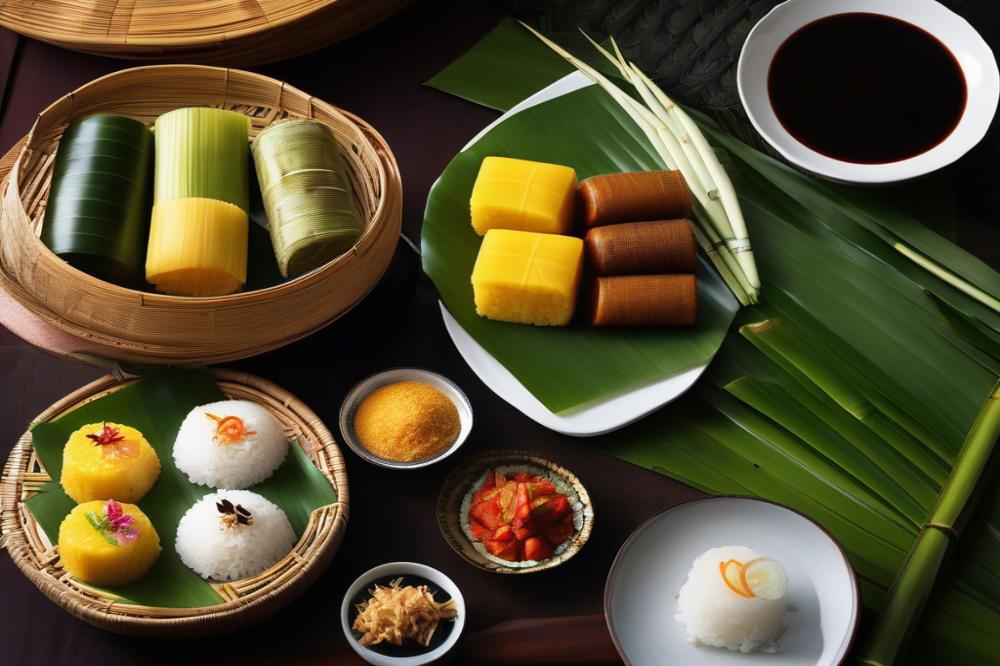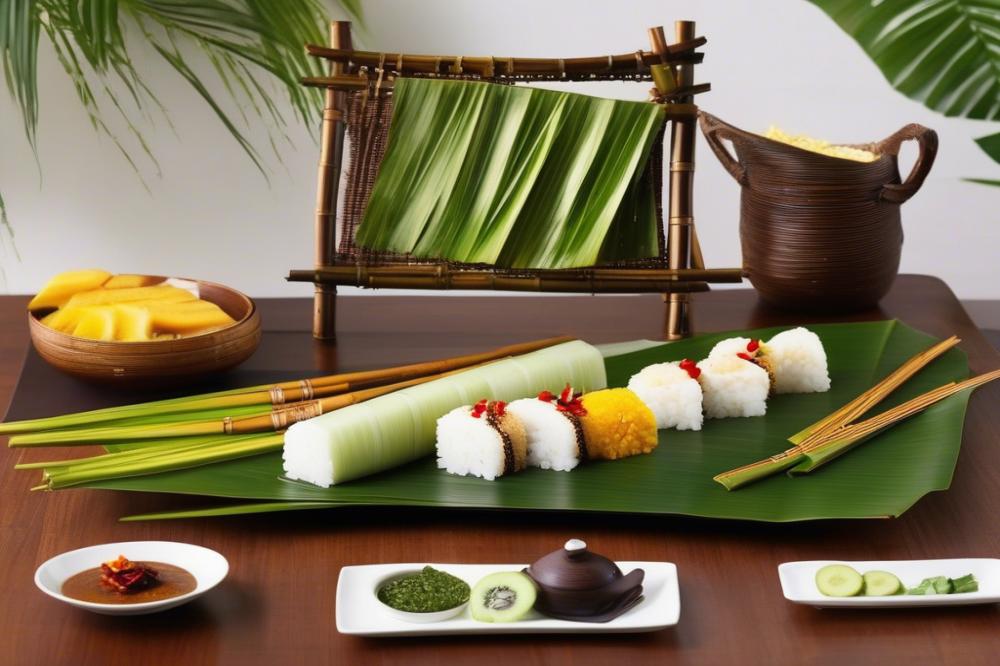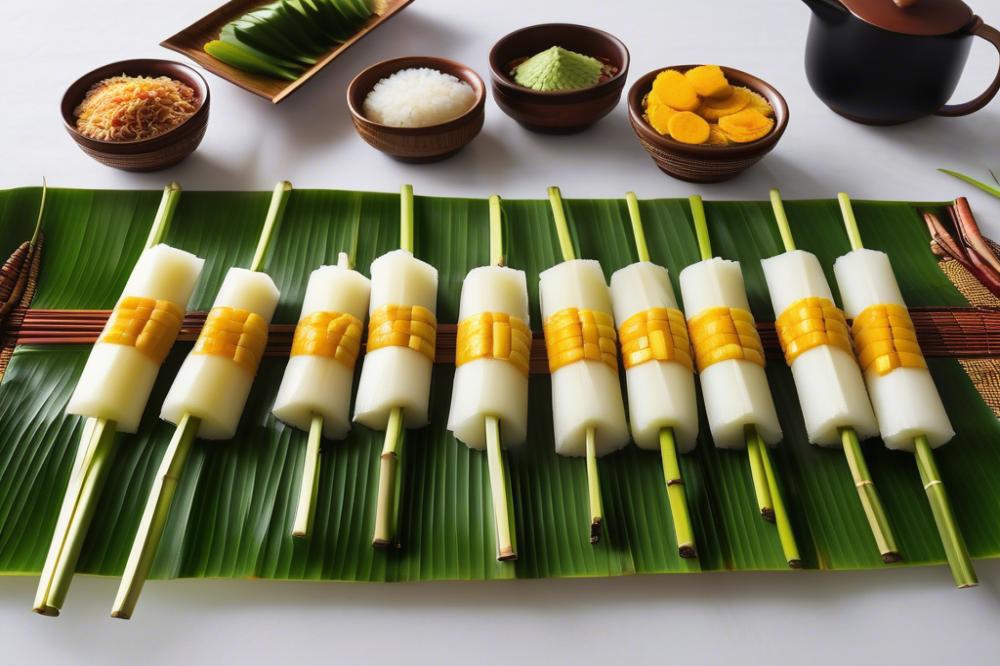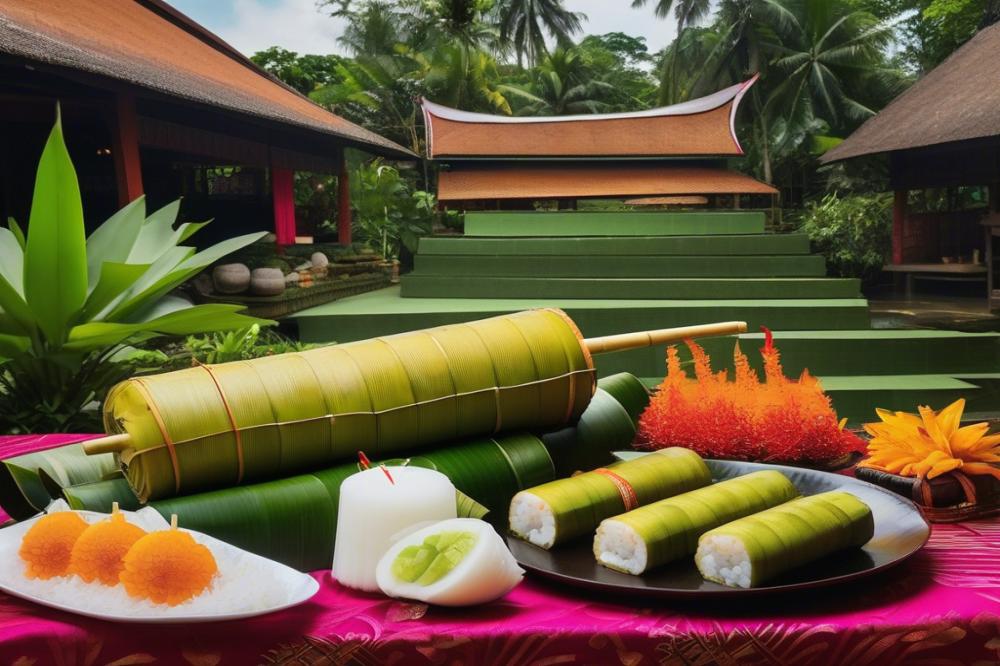Introduction
Lemang is a traditional bamboo sticky rice dish popular in Malaysia and other parts of Southeast Asia. This unique food has deep roots in cultural heritage and is often associated with festive occasions. Families and friends come together to savor this dish during significant celebrations, such as Eid, where it plays a vital role in the festivities.
The recipe for Lemang centers around glutinous rice, which is soaked overnight to achieve the ideal texture. Coconut milk is then mixed in, giving the rice a creamy flavor that complements its chewy nature. The mixture is carefully packed into bamboo tubes, and then it is roasted over an open flame. This cooking method not only enhances the dish’s aroma but also imparts a subtle smokiness.
Lemang serves as more than just a meal; it symbolizes unity and celebration within communities. Each bite offers a taste of tradition, connecting the present to the past. No festival is complete without it, as it holds a special place on the table, often enjoyed with other dishes.
Lemang: The traditional Bamboo sticky rice

Lemang is a delectable dish that showcases the art of cooking glutinous rice inside bamboo. This recipe involves layering the rice with rich coconut milk before sealing the bamboo and placing it over an open flame. The result is a smoky, creamy flavor that defines this traditional food. The texture is chewy yet soft, making it irresistible at first bite.
The history of lemang is deeply intertwined with the cultural heritage of Southeast Asian cuisine. It is believed that this dish originated among the indigenous communities centuries ago. Bamboo was readily available in the forests, and those communities found it to be an excellent vessel for cooking. As these methods spread, lemang became a staple in many households, reflecting the resourcefulness of the region.
Festivals and celebrations often feature lemang as an essential component of the feast. During major festive occasions, families gather to prepare this dish, strengthening bonds and passing down culinary traditions. The sight of lemang being cooked is a cherished part of many festivities, symbolizing togetherness and joy. Its rich flavors bring people together, making it an unforgettable part of their culinary experience.
Ingredients and Cooking Instructions

To create this traditional festival food, gather the following ingredients:
- 2 cups glutinous rice
- 1 cup coconut milk
- 1 tsp salt
- Bamboo tubes (cut to appropriate lengths)
- Banana leaves (for lining the bamboo)
These ingredients highlight the essence of Southeast Asian cuisine, marrying flavors and textures beautifully.
Cooking Instructions
The first step involves soaking the glutinous rice in water. Do this for at least 4 hours or overnight to achieve the desired softness. Next, combine the soaked rice with coconut milk and salt in a bowl. Stir gently until the rice absorbs the flavors.
After mixing, prepare the bamboo tubes. Line them with banana leaves to create a barrier and impart a subtle fragrance. Start filling the bamboo tubes with the rice mixture. Leave some space at the top for the rice to expand as it cooks. Seal each end of the tubes with more banana leaves, ensuring no gaps remain.
The cooking method can be done over an open fire or by steaming. Place the filled bamboo tubes over a fire, rotating them occasionally for even cooking. If using steam, arrange the tubes in a large steamer. Cook for about 2 hours until the rice becomes tender and fully cooked. During this time, the aroma will fill the air.
After cooking, remove the tubes from heat and let them cool a bit. Slice the lemang into sections for serving. This dish often showcases cultural heritage and is a delightful treat during festive occasions.
Nutritional Information

Understanding the nutritional content of this traditional recipe is essential for those who enjoy it during special occasions. Each serving provides a distinct combination of ingredients, offering both flavor and sustenance.
Breakdown of Nutritional Content Per Serving
Glutinous rice serves as the primary component of this dish. Rich in carbohydrates, it contributes to the overall energy content, delivering around 150-200 calories per serving. This type of rice has a unique sticky texture, allowing it to absorb flavors well.
Coconut milk plays a vital role in the preparation. This ingredient adds healthy fats to the dish, with about 5-10 grams per serving, depending on the amount used. Along with calories, it also introduces essential vitamins such as vitamin C and B vitamins, enhancing nutritional value.
The addition of salt is minimal but does have significance. It provides sodium, important for controlling fluid balance in the body. Often, just a pinch is added, keeping the sodium content relatively low while still enhancing flavor.
Health Benefits and Considerations
Bamboo sticky rice can be a delightful part of a balanced diet. The wholesome carbohydrates from glutinous rice help fuel physical activities. With coconut milk’s healthy fats, it can provide sustained energy levels throughout the day.
However, it is wise to consume this dish in moderation. High calorie intake can be a concern for those watching their weight. Additionally, the fat content in coconut milk should be balanced with other dietary elements to maintain overall health.
On festive occasions, the joy of eating this dish becomes part of the cultural heritage of Southeast Asian cuisine. Families often gather to enjoy the rich flavors and aromas that permeate the air. Yet, like all foods, it’s essential to consider the nutritional aspects to enjoy it fully.
Cultural Significance and Modern Adaptations
Role of Lemang in Festive Occasions
Festivals in Malaysia are vibrant and full of life, with food playing a central role. This bamboo sticky rice dish holds a special place during celebrations like Hari Raya. Friends and families gather to enjoy this festival food together. Sharing lemang symbolizes unity and gratitude, core values in Malaysian culture. During festive occasions, it is not just the taste that matters; the cooking method itself can become a communal activity.
Variations in Preparation Across Different Regions
Diverse regions in Malaysia bring their own twist to the traditional recipe. In some areas, the glutinous rice may be mixed with various spices or corn to add flavor. Others prefer a simpler version, focusing on the richness of coconut milk. This variation highlights the distinct cultural heritage within the country. Each area has its unique way of wrapping and cooking, reflecting local customs and preferences. Differences in size and shape also signify different regional practices.
Contemporary Adaptations and Fusion Recipes
Modern chefs and home cooks are exploring creative takes on this traditional dish. Fusion recipes have emerged, combining lemang with other Southeast Asian cuisine elements. For example, lemang can be served with spicy curries or incorporated into desserts. The adoption of new ingredients introduces exciting flavors while respecting the original dish. Creative cooking competitions often showcase these contemporary adaptations. This evolution keeps the dish relevant, bringing it to younger generations while maintaining its cultural significance.
Final Thoughts on Lemang
Lemang plays a significant role in Malaysian cuisine. This dish is not just a tasty treat; it carries deep cultural meaning. Found across various celebrations, it symbolizes togetherness and sharing. People often gather around to enjoy its rich flavors during major holidays, especially during Eid al-Fitr.
Making this dish can serve as a bridge to connect with cultural heritage. Preparing the sticky rice inside bamboo tubes allows families to bond, passing down recipes and techniques from generation to generation. Every step in the process connects you to those who have cooked this dish before, creating a sense of continuity.
Experiencing traditional foods during festivals brings joy and connection. The aroma of freshly cooked rice wafting through the air adds to the festive spirit. Each bite is a reminder of home and community, evoking memories and stories shared around the table. So why not try your hand at making this delightful dish? Dive into the experience, and enjoy the flavors that have united families for years.



